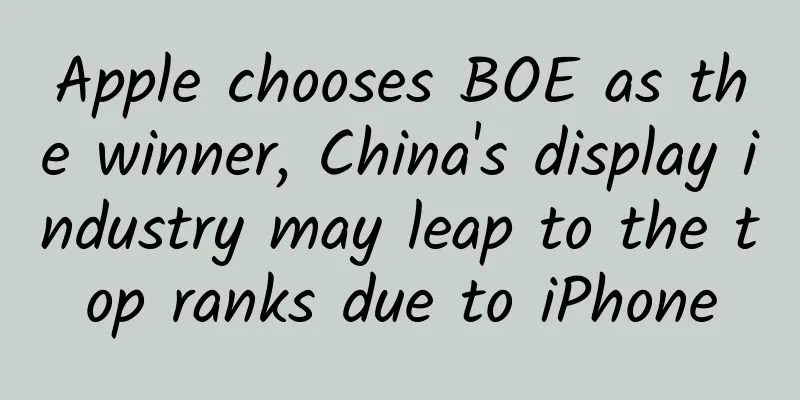Apple chooses BOE as the winner, China's display industry may leap to the top ranks due to iPhone

|
BOE will miss out on the iPhone once again - but this may be the last time. Recently, foreign media revealed that BOE has established a production line called B11 and plans to produce OLED screens for Apple's iPhone 13 in 2021. Although this is just a normal business cooperation between the two companies, due to the current international environment, the high-end positioning of the iPhone and BOE's background as the number one screen manufacturer in China, once the iPhone 13 adopts BOE's screen, it will definitely rewrite the global upstream screen factory ecology, and the arrogant Korean manufacturers will usher in the most violent round of impact. Apple and Samsung's love-hate relationship Many analysts believe that the reason why Apple did not enter the OLED market until 2016 was mainly because Apple needed the market to test the reliability of OLED screens. There were indeed some quality issues in the early stages of OLED development, but in 2016, when Apple entered the OLED market, OLED mobile phone products from Samsung, Lumia, and others had been on the market for more than three years without any serious quality issues. Therefore, there is actually a deeper reason for Apple to enter the OLED market, which is the voice of the supply chain. As we all know, iPhone shipments are calculated in billions each year. If Apple is in a weak position, once the seller supply chain that holds the dominant power raises prices or controls production capacity, Apple's losses will inevitably be calculated in billions. In the LCD era, in order to gain control of the supply chain and reshape the competitive landscape, Apple spent 170 billion yen (about 11 billion yuan) to invest in the declining JDI (Japan Display) to allow it to produce the LCD screens needed for the iPhone. However, after the LCD era, Apple's "buy, buy, buy" strategy began to fail because OLED requires extreme technical background. Currently, only Samsung can produce small-sized OLED screens with high quality, and Samsung and Apple are in competition in business. Obviously, Apple does not want to bet all its treasures on Samsung, so its entry into OLED has been delayed again and again. In fact, Apple's concerns are not unfounded. In 2018, half of the 200 million OLED screens produced by Samsung were used in iPhones, which took out $22 billion from Apple's pocket that year. If it was just a decline in profits, Apple might be able to tolerate it. But Samsung went too far and deprived Apple of the initiative in production. Korean media reported that in June 2019, because iPhone shipments fell short of expectations and OLED screen orders failed to reach the previously agreed level, Apple paid Samsung a fine of $170 million as agreed. Now that Apple has boarded the OLED "pirate ship", its most urgent task is to find a supplier that can counterbalance Samsung, similar to the LCD era. Therefore, we also saw the news that BOE has opened a B11 production line specifically for Apple. More importantly, from the perspective of the entire mobile phone industry, since the current smartphone dividend has dissipated, at a time when Huawei's mobile phones are hit by policies, leading smartphone manufacturers including Samsung and Apple are eyeing a large gap in the high-end mobile phone market in 2021 after Huawei's chips are used up. If this gap is to be filled, the supply of OLED screens has obviously become a top priority. Considering that Samsung's terminal market share has been swallowed up by Huawei, Samsung will more or less act as its own "referee" at the supply chain level, which will also increase Apple's suspicion. Therefore, when we look at the news that Apple will incorporate BOE into its own OLED screen supply system in 2021, it becomes very intriguing. China's screen factories have a bright future Apple's use of BOE's screen in 2021 has the meaning of a spare tire, but for BOE or China's entire upstream industrial chain, Apple's move is of great significance. In the past 20 years, due to the continuous efforts of domestic screen manufacturers, the domestic screen industry chain has first occupied a decisive advantage in the basic LCD market. Data released by Zhiyan Consulting showed that in 2019, domestic LCDs accounted for more than 60% of the global market share. Around 2020, Korean panel companies were forced to announce the gradual abandonment of LCD production lines. On this basis, due to sufficient technical background and overall ecological chain transfer, the domestic screen industry chain has also achieved results comparable to those of Korean panel companies in cutting-edge display technologies such as silicon-based OLED near-eye display and Micro LED display technology. For example, Yole Développement's research data shows that in 2019, BOE topped the Micro LED technology patent rankings, surpassing a number of Korean companies. However, a major problem currently facing the domestic screen industry chain is that it has cutting-edge display technology but lacks high-end terminals to match it. Take Samsung as an example. Since it has a terminal industry, it can control the application of cutting-edge technology at both the terminal and price levels. Foreign media reported that by the end of 2020, Samsung is expected to release Micro LED TV products worth hundreds of millions of won. In 2019, BOE's folding screen technology, which is comparable to Samsung's, finally found a manufacturer like Huawei that has made achievements in the high-end market. However, before the folding screen technology matured, Huawei suffered a blow at the policy level, which actually had a significant negative impact on BOE's folding screen technology. In such an environment, the cooperation between Apple and BOE is meaningful. For BOE, it naturally highlights the potential value on two levels: first, BOE's display technology has reached international heights, and Apple's orders have also invisibly advertised for BOE; second, high-end products reversely empower BOE's display technology, thereby driving the leap of the entire supply chain. From this perspective, if we expand our view to the entire industry, if Apple purchases Chinese display panels on a large scale, it also means that China's local display industry has finally evolved from the stage of simply grabbing the market to a period of sharing industry dividends by relying on technological advantages. Apple's selection of BOE is not only the choice of the industry, but also the inevitability of the times. The Chinese display industry, which has accumulated strength over time, has finally ushered in a major opportunity to leap into the ranks of the world's top supply chains. As a winner of Toutiao's Qingyun Plan and Baijiahao's Bai+ Plan, the 2019 Baidu Digital Author of the Year, the Baijiahao's Most Popular Author in the Technology Field, the 2019 Sogou Technology and Culture Author, and the 2021 Baijiahao Quarterly Influential Creator, he has won many awards, including the 2013 Sohu Best Industry Media Person, the 2015 China New Media Entrepreneurship Competition Beijing Third Place, the 2015 Guangmang Experience Award, the 2015 China New Media Entrepreneurship Competition Finals Third Place, and the 2018 Baidu Dynamic Annual Powerful Celebrity. |
<<: China Mobile Think Tank: 5G-Advanced Security Technology Evolution White Paper
Recommend
Device review and popular science: Antigen testing in the fight against the new coronavirus
Source: China Device Evaluation...
How to write an activity plan? Here are 3 great tips!
At work, we often encounter such problems: The co...
Google crawls 30 billion in-app information and recommends apps when searching for content
Google has just launched a new mobile search feat...
Apple's review guidelines have been updated in as many as 158 places! The most complete and detailed explanation, just save this one
Recently, the WWDC, which has been eagerly awaite...
Subsidies for new energy vehicles are withdrawn, and the income from point trading is only 1/10 of the subsidies
How can enterprises bear the high costs after the...
How to calculate personal income tax on wages in 2020?
Our country's laws stipulate that if a worker...
Are crab sticks really the meat that falls off the crab? Should the plastic film on the surface be cooked together?
Winter is coming How can we miss hotpot? After a ...
Why iOS consumes more power when background apps are turned off manually?
Android phone users should have a habit: when the...
Negative comments about its products continued, and the price fluctuations scared consumers. Tesla's domestic sales plummeted by 60%
Tesla has been in the news recently, but there is...
"I want you" - recruitment copywriting of the thousand-year-old ancient Zen temple, read more than 1,000,000 times, received more than 4,000 resumes
My Buddha is looking for wise men! Recently, Dong...
Longer term trends of the top 10 programming languages ranking (1989-2014)
IOBE has just released the November programming l...
Among all fruit-based alcoholic beverages, why is wine the only one with the greatest influence?
Written by Wei Shuihua Header image |pixabay In t...
Snapdragon 820 version of Samsung S7 latest running score exposed: a new high
As the release is approaching, Samsung S7 is also...
Keeps heat! Keeps cold! Resistant to falling! Waterproof! 13 popular thermos cup reviews you must read
If a cup of milk tea is what wakes up autumn, the...
Jiayuan.com may be responsible for Su Xiangmao's death
Recently, the suicide of WePhone developer Su Xia...









